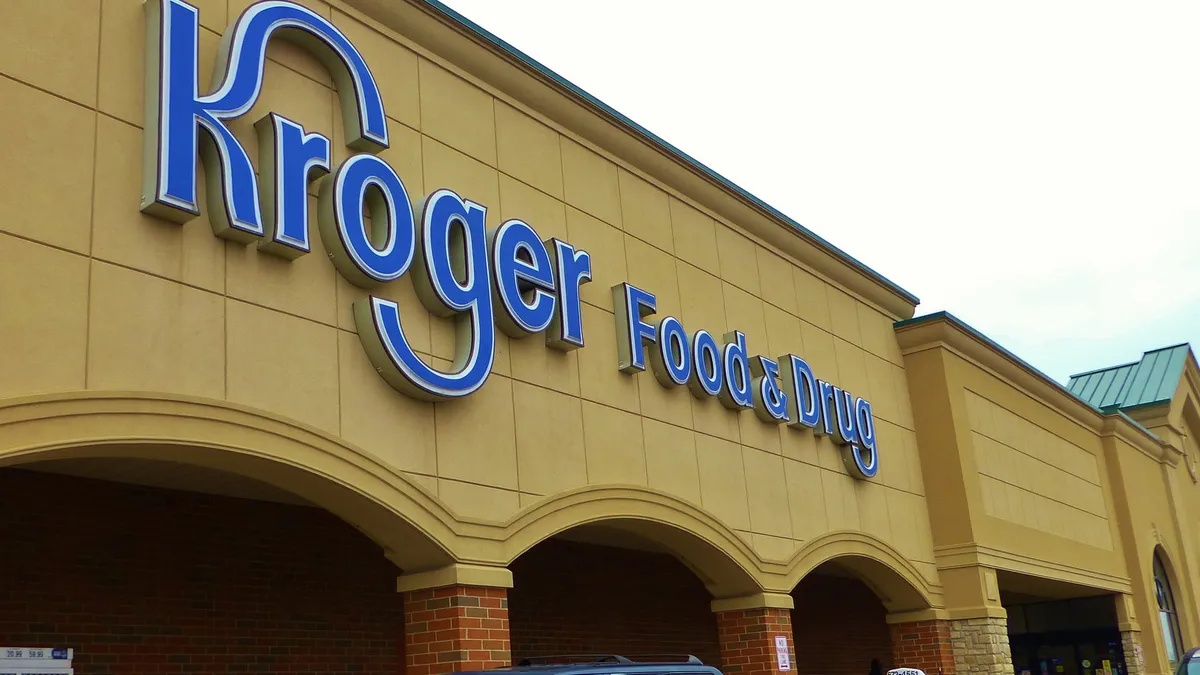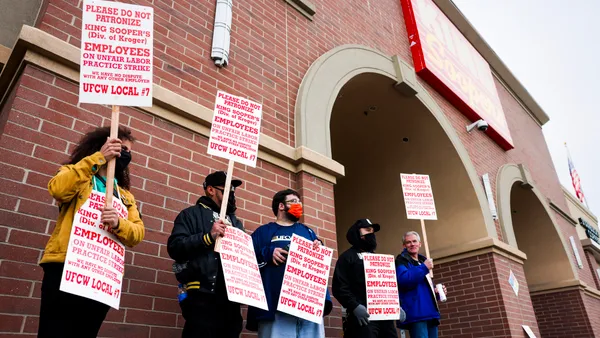Dive Brief:
- Kroger reported net sales of $37.3 billion for first quarter 2019 ended May 25, compared to $37.7 billion over same period in 2018, a decline the retailer primarily attributed to the sale of its convenience store business last year. Adjusted earnings per share was 72 cents, in line with analyst estimates.
- Identical sales fell below company targets, up 1.5% compared to a 1.9% gain during the year-ago period. Gross margin was 22%, a drop of 40 basis points primarily due to lower gross margin rates in pharmacy, according to Kroger.
- Kroger expects its alternative profit streams, which include everything from partnerships to its personal finance service, to contribute $100 million in incremental profits this year. The company also reaffirmed its guidance for the year, with ID sales growth expected in the range of 2% to 2.25% and adjusted earnings per share between $2.15 and $2.25.
Dive Insight:
After a weak fourth quarter showing in March that included a margin slide of 93 basis points, investors and industry observers were eager to see the next progress report from Kroger. What they got was an improved quarter that fell in line with analysts' expectations. But the results won't do much to boost optimism for the retailer's long-term outlook.
On the plus side, Kroger's digital business continued to show solid growth, with sales up 42% for the quarter. Kroger's pickup and delivery locations now reach 93% of households in the company's operating footprint. Private label sales also continued to grow, with sales up 3.3% and more than 200 new products introduced to stores.
These gains, however, did little to improve the profitability of Kroger's overall business. Kroger's year-over-year sales have declined the past three quarters. And although the gross margin slide this quarter was roughly half what it incurred in Q4, it still underscores the massive competitive pressure and steep investments Kroger faces as all sorts of retailers take aim at its core grocery business.
Kroger has pinned a lot on its alternative revenue streams, which are "margin-rich, asset light" strategies that utilize the company's grocery data assets. This includes established business segments like Kroger Personal Finance and Kroger Precision Marketing, as well as a raft of newer opportunities that are still in the "incubation" phase, as CEO Rodney McMullen noted in Thursday's earnings call. This includes its recent formation of PearlRock Partners, which aims to find and groom promising consumer product companies, as well as various initiatives with Walgreens like a store-in-store concept and online order pickup.
To support these alternative investments, Kroger has shuffled its executive deck and brought in more outside talent, McMullen said. Asked during a question-and-answer session with analysts if the company has the internal infrastructure necessary to navigate the significant changes it's facing, McMullen said he believes so.
"It's a topic we talk about routinely," he said. He cited the company's hiring of outside talent, its executive changes and establishing alternative revenues as a separate department within Kroger as key to its work.
Approaching the halfway point of Restock initiative. Kroger has made numerous and diverse investments to try to transform itself from a traditional grocer into a modern food retailer. Time will tell if it will all pay off, though investors will hope to see significant traction by this point next year. McMullen noted Kroger sees health and wellness as a promising focus for future alternative investment, in particular the "food as medicine" movement, he said.
Mickey Chadha, vice president and senior credit officer with Moody's, struck an upbeat note in an email sent to Grocery Dive, pointing out that Kroger has reduced debt by $1.7 billion so far this fiscal year. Chadha believes Kroger is going through the hard, but necessary steps it needs to take on the road to transformation.
"We continue to expect 2019 to be a transition year for Kroger, with returns on its investments in the Restock Kroger plan starting to accelerate in 2020," he wrote. "More importantly the company is right sizing its capital structure to conform to its profitability levels as the business environment remains very competitive."













